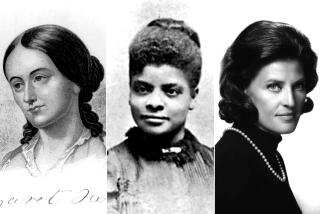Putting Women’s Education to Work Could Enrich U.S. Economy : Competition: America has the best educated female work force in the world; now it must get smart and use that talent fully.
- Share via
WASHINGTON — The economic pundits are fingering their worry beads and pronouncing the doom of the United States’ work force. It will be wholly eclipsed, say columnists in publications ranging from Newsweek to Barron’s, by those of other advanced post-industrial nations. We are unprepared for the upheavals and opportunities of a global economy, this school of thought would teach us, and ultimately our standard of living will fall.
Reality teaches something else: If we play it right, if economic justice can determine economic strategy, the women of the United States will make the difference. We will not be eclipsed. If we play it right--and just.
The United States will enter the next century with a remarkable edge over its global competitors. U.S. women, of all races, are the best educated and trained in the world. They will constitute 64% of the new entrants to the work force over the next 10 years. U.S. women now comprise more than half of enrollees and degree recipients at all levels of higher education--except the doctorate. In contrast, women constitute only 42% of higher education enrollees in what was West Germany and 34% in Japan.
Labor market equity in the United States, sadly, is another issue. “Americans are missing something,” says Kerstin Keen of Volvo. Keen, who wrote a work-force education report on behalf of 24 major European corporations, adds, “You’re not utilizing women as well as you have prepared them.”
The most telling evidence of this unhappy paradox comes from the richest archive ever assembled on a generation of Americans--the U.S. Department of Education’s study of the high-school class of 1972. The 22,600 men and women who initially participated in this survey are now “thirtysomething,” and represent the “critical knowledge work force” of the year 2001. While there are dozens of stories in their records over 14 years, the most stunning is that of the women.
Consider, first, the evidence of women’s superior academic performance:
--Matching women and men who took equal amounts of math or science in high school, the mean class rank for women exceeded that for men by 10 points. That is: Women beat men on conventionally “male” turf.
--The parents of the class of ’72 had lower educational aspirations for their daughters than they had for their sons. The daughters themselves had lower educational aspirations than the sons. Yet a higher percentage of women than men entered college directly from high school and won scholarships.
--Once in college, women earned consistently higher grade-point averages than men, no matter what field they studied. The differences in performance are greatest in matching women and men who majored in science, business and engineering, traditionally “male” fields.
--Achievement in college had a striking impact on the further educational plans of women in the class of ’72. When they were surveyed in 1976 and 1979, the proportion of those aspiring to graduate degrees vaulted over that of men.
These data show that women’s aspirations are less inflated than men’s, their plans more realistic, their focus on goals more intense. They do what they say they will do. Women “walk away from their pasts” in late adolescence, Mary Belenky and her colleagues wrote in “Women’s Ways of Knowing.” Further education supports their development. And further education--along with realistic plans and determination--is the basic currency of the world economy of the 21st Century.
The U.S. economy, however, seems to discount all the evidence of women’s superior educational performance and commitment. Between age 25 and 32, a substantially higher percentage of women from the class of ’72 experienced genuine unemployment and underemployment than did men. This experience was as stubbornly true for women who earned bachelor’s degrees as it was for those who earned no degree. And at age 32, the women who were college graduates tended to hold lower-paying and traditionally female jobs--for example, nursing and health technology (11%), teaching (23%) and office or financial-services support (9%).
The data are dry; the stories are not. Janice, for example, a former student of mine in a mass-communications course, was always prepared, articulate and searching for knowledge beyond the course syllabus. She organized three or four of her peers to do a group study that involved commuting to Manhattan to interview TV rating service researchers. She stood out in a class of 140.
Janice graduated in 1978, with a major in allied health sciences. Three years later, she was passing out towels in a health club in downtown Washington, waiting for a job testing exercise equipment in Pennsylvania or one in a physical therapy clinic in New Jersey. And out of work for two months before she started passing out towels.
We’re not talking here about the “glass ceiling,” that fragile metaphor for the barrier between women in management careers and the executive suite. We’re talking about the entire labor market for jobs requiring more than a high-school education, and Janice, a state college graduate of some promise, was typical.
Even more telling than the experience of unemployment or underemployment are earnings differences between women and men with the same undergraduate backgrounds. If one restricts the women in this comparison to those without children--the group with as many years of job experience as men--the bottom line is devastating. Our analysis of data, reported in 1986, indicates that men who majored in fine arts earned, on average, 15% more than the women; men who majored in foreign languages earned 54% more than the women, and men who majored in education earned 26% more than the women. These fields are supposed to be female turf.
In only four major occupations did the women college graduates earn more, on average, than men: chemist, economist, computer programmer and purchasing agent--all requiring solid backgrounds in mathematics. In five other major occupations--accountant, editor/reporter, physician, engineer, health technician--differences in earnings were insignificant. Appearance and dress are not keys to mobility in these occupations. Despite messages from the Glamours of this world, women achieve pay equity in fields requiring substance more than fluff.
Outside of these occupations, however, earnings differences in favor of men ranged from 15% for pharmacists to 42% for retail sales managers to 77% for architects.
Despite this discouraging pattern, a much higher percentage of women than men who attended college--no matter what degree they earned--reported at age 32 that their learning and training were relevant to their work. In other words, women tend to use what they’ve learned more than men. Perceptive employers agree. “Women come into the workplace like immigrants,” said Harold Tragash, vice president for human resources at Rorer, “determined to succeed on the basis of what they know, not who they know.”
Tragash sees women more likely than men to “influence co-workers from a technical knowledge base.” People who do that can change the knowledge with which we work, and that ability is critical to innovation in manufacturing, services and public administration. Innovations stemming from this supply of knowledge that women, in particular, bring to the job can make the difference in our economy in the 21st century.
It has been frequently observed that women make occupational choices for more complex--and personal--reasons than do men, and those reasons do not always include economic self-interest. The currently fashionable argument built on this observation is that women will continue to perform well academically and then contribute their knowledge to the workplace regardless of economic rewards. This argument unwittingly condones both the exploitation of women and economic stagnation.
Why? First, because it does not encourage anyone’s educational achievement. It certainly does not tell men, who have been slacking off in school and college for decades, that genuine knowledge counts. Second, because it does not encourage the sharing of knowledge for the good of any enterprise. If we take women’s contributions for granted at the same time as we treat men’s knowledge as proprietary and rewardable, we have a half-economy.
The rest of the world doesn’t behave this way. Other nations may not educate as high a percentage of women beyond high school, but their economies do not leave a Janice passing out towels in a health club at age 25.
Our national rhetoric holds that education is ultimately an economic investment on behalf of the whole society. The history of the high-school class of 1972 strongly suggests that women can prove that point. The coming century is theirs to do so. But if the market rewarded women’s attainments, everyone would benefit. That’s playing it right--and just.
More to Read
Inside the business of entertainment
The Wide Shot brings you news, analysis and insights on everything from streaming wars to production — and what it all means for the future.
You may occasionally receive promotional content from the Los Angeles Times.







